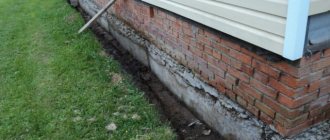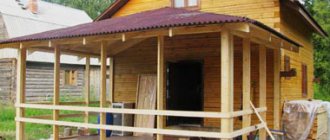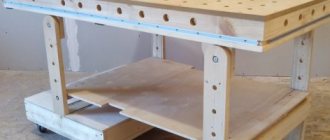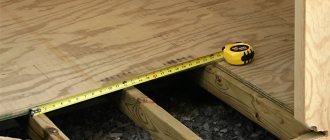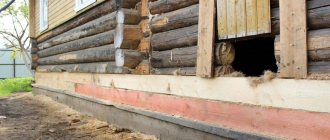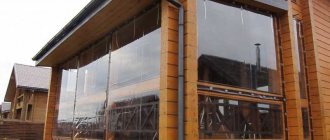City sewer - this is the main channel that collects and discharges wastewater to treatment facilities. Traditionally, it is laid underground, below the freezing level of the ground. If we judge such a system from an engineering point of view, then this is just a pipeline with a large diameter, and it is larger than other pipes in the system. We will begin to consider the description of the device from the other end of the system, namely the networks that are connected to homes.
storm sewer collector
English-Russian Dictionary of Technical Terms. 2005.
See what a “storm sewer collector” is in other dictionaries:
storm sewer collector — — Energy industry topics in general EN storm sewer ... Technical Translator's Guide
SEWER WATER COLLECTOR - a collector for collecting and discharging wastewater from the storm sewer network (Bulgarian language; Български) drainage sewer collector (Czech language; Čeština) dešťový kanalizační sběrač (German language; Deutsch) Abwassersammelkanal (Hungarian ... ... Construction Dictionary
sewer drainage collector - Collector for collecting and discharging wastewater from the storm sewer network Topics water supply and sewerage in general EN storm sewerstormwater sewer DE... ... Technical Translator's Guide
Kamenka (river, flows into the Sea of Japan) - This term has other meanings, see Kamenka. Kamenka Upper Kamenka Characteristics Length ... Wikipedia
Samorodinka (river) - Samorodinka Valley of the Samorodinka River Characteristics Length 7 km Basin area 11 km² ... Wikipedia
Flon (river) - Flon fr. Flon Upper reaches of the Flon ... Wikipedia
Igumenka (river, Chelyabinsk region) - This term has other meanings, see Igumenka. Igumenka is a small river in the city of Chelyabinsk, 9 km long, a right tributary of the Miass River, almost completely enclosed in a collector. When open, it leaks from... ... Wikipedia
Collector wave - A collector wave is the occurrence of a large flow of water in the collectors of underground rivers and streams during a rainstorm. This is due to the fact that storm sewer systems are usually connected to the collectors of underground reservoirs. Therefore, during... ... Wikipedia
Underground passages of Minsk - The building of the Republican Prosecutor's Office on the site of the former Church of St. Wojciech There are not many historical dungeons in Minsk, mainly in the historical center in the area ... Wikipedia
dic.academic.ru
How to choose
Before purchasing a water heating manifold, be sure to consider factors such as:
the total area of the room in which the system will be used;
water consumption;
performance parameters - it is very important that this coefficient corresponds to the flow rate of liquid, which is distributed to all consumers;
budget – the price of a water distribution manifold directly depends on the characteristics of the system;
pressure parameters.
The cost of a water catcher varies depending on the type, shape and manufacturer. In our catalog you will find high quality components that are best suited for your systems.
A water collector is exactly the type of element whose use is advisable not only in a house or apartment, but also in a country house.
Construction of a sewer collector
Sewage collector is a system of pipes and pipelines designed to carry sewage and waste to a collection point, which is usually served by a reservoir or, simply, a cesspool. This is the most standard sewer well device, however, there are other, more complex, but also more practical, sealed and non-poisonous soils. Absolutely all types can be equipped with your own hands, all you need is an investment of finances and labor costs.
Methods for arranging a sewer collector
It is worth immediately noting that this is not a heating collector, but another device, which is a pipeline from a system of pipes laid in trenches. Sometimes a sewer structure is called a channel, and this will make it clearer what a sewer collector is and why it is needed.
A regular cesspool is a device that receives all wastewater. At the same time, a pit can be equipped literally in a matter of hours, simply by digging a foundation pit on the site, covering it with brick or something else, as shown in the photo. At the same time, we must not forget that the drain must be cleaned using a vacuum cleaner.
A septic tank is another option for collecting sewage and waste. As shown in the photo, this is a sealed structure that accepts a piping system that transports drains from plumbing fixtures. Such a device requires some preparatory work, but the general principle is the same: a pit is dug into which a reservoir is mounted, drainage pipelines are connected to it, and then the sewerage collector is put into operation.
Installation of a sewer collector
The collector structure is shown at the stage of laying the foundation. The process is simple and does not take much time:
- Below the freezing point of the soil, a trench is dug for the pipeline,
- A sand cushion (up to 20 cm thick) is placed at the bottom of the trench, compacted,
- Pipes are placed on top. For a gravity sewer system, the pipeline is installed with a slope towards the collector reservoir. The maximum slope size is 2 cm per 1 m of pipe,
- The pipeline is insulated,
- The tightness of the joints of the elements is checked by filling the structure with water,
- The trench is dug, the outlet of the pipeline is first lowered into the hole or connected to a septic tank, as shown in the photo.
The system is installed in pressure structures, which are installed in cases where gravity sewerage cannot be installed for one reason or another. Pressure sewerage consists of a tank for collecting wastewater and a pipeline. The line of pipes laid in trenches rises as it approaches the wastewater reservoir, and to prevent the flows from stagnating, the sewer collector is equipped with a pump. Such a system ensures ease of laying sewerage on any terrain and helps to increase the cleanliness of the system as much as possible.
The sewer collector is an important part of the sewerage system, without which it is impossible to construct an autonomous structure. Therefore, the arrangement of the pipeline and reservoir requires care and patience.
Location rules
The design of a collector in a private house has a lot of nuances and begins with the design of the system. A special role here is played by the correct placement of the component parts of the device.
The location of the elements of the sewer system is influenced by the terrain, the climate in the region, the depth of soil freezing and the occurrence of groundwater. In addition, the types and parameters of equipment (pump, septic tank) should be taken into account. The need for equipment at the entry point for the sewer truck will depend on this.
To ensure safe sewerage, experts advise:
When laying a sewer line, you should choose pipes that are resistant to corrosion and aggressive agents. The angle of inclination of the collector must be calculated based on the diameter of the pipes: the larger the diameter of the pipeline, the smaller the slope the system should have. In order to prevent overflow of the water supply and treatment facilities, it is necessary to first calculate the collector.
Pressure sewerage system made from pipes
The main element of the pressure sewer system is the SPS (sewage pressure station). The sewage pumping station collects all wastewater located in the internal pipelines of the building. The force of a powerful pump transports waste to the place of disposal. The pumping station operates as a storage tank, but only up to a certain level (for more details: “KNS sewage pumping station - principle of operation and types of installation”).
If such a distance cannot be ensured for one reason or another, or if sewer pipes must be laid higher than water pipes, then protective measures must be applied. Such measures may include laying a water pipeline from steel pipes or a sewerage system from cast iron, laying a water pipe in a protective case with a length of at least 5 m in each direction from the intersection in clay soils and 10 m in filtering ones.
If the sewer collector crosses the walls of tunnels, chambers, basements, etc., it must be enclosed in a case, the ends of which extend 0.2 m from the outer plane of such walls. The vertical distance between the sewer pipe and other communications intersected in the tunnel is at least 0.15 m.[.
The reasons may be different:
• if there is no free-flow sewer nearby for tapping, pressure sewers pass nearby, and water discharge into free-flow networks is impossible; • if the organization of a natural slope is impossible due to the large distance to the free-flow collector; • if the water intake point is located at a great depth; • if laying a gravity sewer is expensive or troublesome.
How to install polypropylene pipes?
Which radiators are preferable to use in an apartment or house?
www.684015.ru
Installation according to the collector circuit
Manifolds are made of brass, stainless steel, polyethylene or polypropylene.
Polymers are no less durable than metal, and such products can be used with the same efficiency. Metal collectors are threaded. The plastic is welded, and the metal-plastic elements are connected with suitable compounds.
If you contact a specialized company, you will be provided with a final offer indicating prices for all system components and installation work.
When you decide to assemble the system yourself, you need to take into account a number of features and recommendations from experts:
- The purchase package must include the goods that will be needed during assembly.
- Connections can be combined to provide a transition from metal to plastic or metal to plastic in any combination.
- The number of branches is equal to the number of connected devices. Typically, one to six taps are sufficient in an apartment.
- It is allowed to connect two or more collectors in series with different numbers of taps.
- Several manifolds are used for cold and hot water.
Collector type water supply scheme
The choice of materials and components is not the only feature. The work is also carried out according to a set of rules. But the main differences lie in the type of system. This can be cold or hot water supply, as well as heating.
Water supply
When choosing pipes, it is necessary to take into account the temperature regime. Metal and metal-plastic pipes are suitable for hot water supply, if the latter have special marks. A cold water supply system can be organized using plastic pipes. However, it should be taken into account that they cannot be faced with bricks due to the fact that they are subject to a high degree of thermal deformation.
It is allowed to use equipment when the wiring is hidden in the walls or floor. There are a number of restrictions here. Walls cannot be reinforced concrete, load-bearing structures. Hollow slab ceilings do not have channels. But if the house is brick and the floor is a monolithic slab on the ground, then this can be done. An alternative is screed pipes.
Heating
A feature of the collector wiring is the separate connection of each radiator, room, floor, and so on, thanks to this the coolant is preserved. If part of the house is not in use and there is no need to heat it, simply turn it off or reduce the circulation, maintaining an acceptable minimum.
The advantages of such a system are similar to those of identical hydraulic systems. There is no need to turn off the boiler during repairs and maintenance. But the disadvantages are still the same. Large supply of materials, complexity of installation and, as a result, high estimated cost. But by sealing the pipes in the screed, you can assemble a “warm floor” system. This way the pipeline and radiators will not spoil the interior of the room.
Sewer collector
Great Soviet Encyclopedia. - M.: Soviet Encyclopedia. 1969—1978.
See what a “sewer collector” is in other dictionaries:
sewer collector - sewer collector Pipeline of an external sewer network for collecting and discharging wastewater. sewer collector A section of an external sewerage network for collecting and discharging wastewater from one or more swimming pools... ... Technical Translator's Guide
Sewer collector - a pipeline of an external sewer network for collecting and discharging wastewater. Sewer collector A section of an external sewer network for collecting and discharging wastewater from one or more sewer basins.... ... Encyclopedia of terms, definitions and explanations of building materials
Collector (sewer) - Collector of the Neglinka River in Moscow. This term has other meanings, see Collector. Collector is the main channel of the drainage network. Imagine... Wikipedia
sewer collector - 3.9 sewer collector: Pipeline of an external sewer network for collecting and discharging wastewater. Source... Dictionary-reference book of terms of normative and technical documentation
SEWER COLLECTOR - a section of an external sewer network for collecting and discharging wastewater from one or more sewerage basins (Bulgarian language; Български) sewer collector (Czech language; Čeština) kanalizační sběrač (German language; Deutsch) Sammler... ... Construction Dictionary
basin sewer collector - A collector designed for collecting and discharging wastewater from the sewer network of one sewer basin Topics water supply and sewerage in general EN... ... Technical Translator's Reference
sewer drainage collector - Collector for collecting and discharging wastewater from the storm sewer network Topics water supply and sewerage in general EN storm sewerstormwater sewer DE... ... Technical Translator's Guide
main sewer collector - A collector that collects wastewater from two or more basin sewer collectors Topics water supply and sewerage in general EN main sewer DE... ... Technical Translator's Guide
suburban sewer collector - A collector that discharges wastewater in transit outside the city to pumping stations, wastewater treatment plants or to the point of discharge into reservoirs. Topics: water supply and... ... Technical Translator's Guide
sewer unloading collector - A collector installed in the system of an existing sewer network to unload existing sewer collectors that do not have the required throughput. Topics... Technical Translator's Directory
dic.academic.ru
How to install
When installing parallel wiring in an apartment, the main branch does not have branches; it is attached to the distributor to which the power lines are connected.
To install the comb, you need to purchase tools. The process consists of several stages:
- Ball valves are installed where the comb is attached to the main branch. This is necessary for isolation from the general water supply.
- a coarse filter is installed. This measure will prevent large particles from entering the devices when dirty water circulates through the pipes.
- Measuring instruments have been installed.
- After installing the meters, you can install fine cleaning devices (optional).
- it is installed to prevent water from flowing back from the distributor into the riser when the flow rate decreases.
- In a private home, it is recommended to install a pressure reducer. If there is excess pressure, excess liquid will flow into the sewer.
Then the collectors are mounted: separately on the cold and hot water risers. Each branch is equipped with a valve. The decisive point is the number of consumption points corresponding to the number of outlets. Only when cold water is supplied, the comb outlet directs water to the heating device. From the water heater, the liquid flows into another manifold to distribute hot water.
Hidden installation of the collector is possible due to the lack of communication between the device and other devices. When installed hidden, pipes with cold water are hidden in a special polyethylene (foam) sleeve. The distance will compensate for thermal expansion.
If the water supply, in addition to heating radiators, has circuits for heated floors, it is recommended to install mixing units in the connections. The water will circulate in an isolated circuit at a lower temperature, the unit will add hot water as the floor cools. However, installation is not carried out if the system consists only of heated floors. An armature with mechanical drives is attached to the return collector.
If the circuits differ in length when connected to the same valve, it becomes necessary to install a balancing flow meter. The ability to pass water is adjusted by turning the ring. The exact range is displayed in the scale window.
When installing water supply distribution, no control valves are needed, because they are completely turned off. The devices are mounted in wall niches in dry rooms. The device is often placed in the toilet. It is recommended to install the devices in suitable cabinets.
Sewer collector - all about the main element in the sewerage system
Today it is difficult to imagine the appearance of modern cities if all wastewater were not disposed of by the sewer system. Without its development, installing a toilet inside a residential building would have been impossible. As a result, the installation of a sewer system is one of the most important tasks during the construction of a multi-storey, private house or country cottage. The entire system is connected by a sewer collector.
Problems of drainage care in cities
Every home, business, and public institution needs drinking and industrial water, which forms wastewater. The internal sewer system is connected to the street sewer, except in cases where the wastewater is treated by individual treatment plants.
A slope is always provided for drainage of wastewater, so it is not difficult to connect the building’s sanitary equipment to the public sewerage network. But in cities it often happens that the room is located below the level at which the sewer is located, and there is no free flow. If it is not actively filled, then it is not possible to remove wastewater from such premises. However, if the collector is subject to heavy filling, backwater occurs, which leads to flooding by backflow of water.
To solve this problem, a non-return valve is used, which protects the room from flooding. Also, in low-lying areas of the city, a pressure sewer is used, which can more efficiently receive wastewater. Individual pumps can be installed to improve the removal of wastewater from low areas of the city.
Note! For these purposes, it is recommended to use pumps that operate autonomously.
Pump - help for drowning people
The problem of sewerage connections is acute for residents of private houses. Let's figure out how to do this and connect to the collector output. This is the main task if the house does not have individual treatment facilities. For houses located on a hill, everything is very simple: a sewerage connection is made with access to the street communications network, and waste flows into them by gravity. It is more difficult if the house is below the level of the collector. Then it is necessary to make a pressure sewer with a pump.
For such sewerage, two types of pipes are used:
- Polyvinyl chloride (PVC),
- Polyethylene (PE).
Pipes with a diameter of up to 90 millimeters are supplied in coils, which reduces installation time. The pumping station can be located both inside the house and outside. The pump can operate for a long time without overheating, thanks to its reliable design, which gives the device greater strength.
Note! In a reliable pump, all parts are made of high-strength steel, only this can serve as a guarantee of its quality.
Principle of operation
In order for all the waste to get into the collector, a properly executed sewerage connection is necessary, only this guarantees reliable drainage of wastewater. The correct system functions as follows: all waste is moved into a special sealed container, then it is crushed by a pump and pumped into treatment facilities and a collector.
Important! Designing a pressure sewer is a complex undertaking, so it is better to contact a specialist. The diameter of the pipes for such a system is 32 millimeters, and their thickness is calculated so that the flow speed is no more than 0.7 meters per second
When this speed is reached, the self-cleaning system of sewer pipes comes into play.
The diameter of the pipes for such a system is 32 millimeters, and their thickness is calculated so that the flow speed is no more than 0.7 meters per second. When this speed is reached, the self-cleaning system of sewer pipes comes into play.
Advantages of pressure sewerage:
- The volume of excavation work performed is less,
- By using less material over longer distances, the cost is lower,
- Installation time is reduced,
- The service life of such a system is designed for 50 years.
Location rules
The design of a collector in a private house has a lot of nuances and begins with the design of the system. A special role here is played by the correct placement of the component parts of the device.
The location of the elements of the sewer system is influenced by the terrain, the climate in the region, the depth of soil freezing and the occurrence of groundwater. In addition, the types and parameters of equipment (pump, septic tank) should be taken into account. The need for equipment at the entry point for the sewer truck will depend on this.
To ensure safe sewerage, experts advise:
- Place the septic tank at a distance of 5 m from a residential building and 1 m from residential buildings;
- Locate treatment facilities at a distance of 30 m from wells and wells with drinking water;
- Place VOCs at a distance of 10 m from rivers and streams;
- Place waste collection and treatment stations at a distance of 30-50 m from the nearest natural bodies of water.
Before building a collector, you should consult with specialists. To lay the sewer main, you should choose pipes that are resistant to corrosion and aggressive agents. The angle of inclination of the collector must be calculated based on the diameter of the pipes: the larger the diameter of the pipeline, the smaller the slope the system should have. In order to prevent overflow of the water supply and treatment facilities, it is necessary to first calculate the collector.
Types of wells and installation locations
The main task of wells is to monitor the general condition of systems.
Not so long ago, only concrete was used to create wells.
Reinforced concrete products such as rings, covers with holes for manholes, and bottoms, which are currently produced in large quantities, are used in the installation of high-capacity storm sewers.
In private houses, they made cesspools with their own hands, digging holes to a certain depth. After this, the walls were covered with bricks and waterproofed.
Today, concrete wells have faded into the background, giving all the laurels to plastic or fiberglass products. In addition, the developers of these wells have made a huge range of sizes, and this is very popular with designers when creating modern wells.
A well is a closed cylindrical vertical working chamber with embedded inlet and outlet pipes for the purpose of connecting to a storm sewer pipe system.
The well also has an inspection window or a service hatch, which allows you to go down to check the sewage system.
Another advantage of plastic wells is their ability to be assembled and disassembled.
Inspection wells in accordance with SNiP 2.04.03-85 are required to be installed:
- At the confluence of two or more water streams.
- At points where the direction of the sewer system changes.
- In places where the slope of the pipes varies.
- At points where a transition is made from pipes of the same diameter to other pipes of different diameters.
- On straight sections - at certain distances, depending on the diameter of the sewer pipe, for example:
- DN up to 150 mm – 35 m;
- DN 500-600 mm – 75 m, etc.
- DN 200-450 mm – 50 m
The dimensions of the pipes used will determine the diameter and height of the well.
In order to reduce hydraulic resistance in rotary wells, inserts are often used - these are gutters with a guiding function that ensure trouble-free passage of water flow in the required direction.
Wells are a very important element in the treatment of storm water collection.
Cleaning the cavity of a well is much easier than cleaning storm drains or flushing clogged or silted pipes.
For special differential wells, it is necessary to change the depth of the sewer pipes.
In this situation, the location of the outlet pipe of the required diameter should be higher than the inlet.
This may be relevant if it is necessary to reduce the depth of laid sewer pipes or to bypass underground obstacles. The installation of a storm drainage system at an industrial facility involves exceptional purification of the water flow before it is taken into a reservoir or onto a field with filtration.
In this case, specialized wells are equipped to take samples for the content of chemical components or suspended petroleum products in the water. They are installed after local stormwater treatment facilities in front of the output storage tank-collector.
Polyvinyl chloride
PVC pipes are environmentally friendly. PVC pipes, specially made for pressure sewerage, are used in private homes, as they are environmentally friendly and safe for health. Such pipes are not flammable and do not emit harmful substances and hazardous chemical compounds in the event of a fire. PVC is resistant to temperature changes, is not afraid of ultraviolet radiation and is not exposed to aggressive environments. The presence of chlorine atoms in the composition of polyvinyl chloride makes pipes made from it indispensable in fire-hazardous areas, since such a compound gives the material the ability to self-extinguish and contributes to the speedy elimination of a fire.
https://masterseptika.ru/youtu.be/MJamp08QWU4
The throughput of the pipes is high, and the possibility of self-cleaning allows the system to clog less often. In this case, no additional processing is required, there is no need for painting or applying a special layer, PVC resists the effects of external factors well. PVC pipes are durable and will last a long time. For a private home, they may be more suitable than cast iron ones, as they are light in weight, which makes installation easier. They are connected either by welding or using embedded couplings, which provides good sealing and does not require heavy and complex special equipment.
Storage collectors for storm sewers
No matter how extensive the storm sewer project is, as a rule, it is “tied” to a single specific spillway point.
Thus, water flows are collected in one single channel or reduced to one reservoir. This deep technical plumbing equipment is called a manifold.
The collector can be a pipe made of reinforced concrete or polymer material, which is located horizontally. Pipelines from all water collection areas must cut into it.
If the collected water requires additional purification, then special filters of various types of purification should be placed on the collector.
After this, the water is diverted to drainage fields or discharged into reservoirs.
It is often more profitable to divert water into closed collectors than to discharge it. Closed-type collectors are sealed products with one chamber and the ability to purify water.
If you use a closed cycle on a storm sewer system, you can achieve significant water savings. This technique is used in industrial enterprises (such as, for example, car washes).
In a private home, such a technique can bring many benefits. As a rule, storm water in these situations is not contaminated and after stages of purification in sand traps for storm sewers, as well as after settling in closed-type collectors, this water can be used for domestic or agricultural purposes. In order to economically use storm water for these purposes, it is enough to install a submersible pump.
Often, instead of a collector, the above large wells are used. They can still collect rainwater and divert it to discharge points.
v-dom-voda.ru
Polyvinyl chloride
PVC pipes are environmentally friendly.
PVC pipes, specially made for pressure sewerage, are used in private homes, as they are environmentally friendly and safe for health. Such pipes are not flammable and do not emit harmful substances and hazardous chemical compounds in the event of a fire. PVC is resistant to temperature changes, is not afraid of ultraviolet radiation and is not exposed to aggressive environments. The presence of chlorine atoms in the composition of polyvinyl chloride makes pipes made from it indispensable in fire-hazardous areas, since such a compound gives the material the ability to self-extinguish and contributes to the speedy elimination of a fire. The throughput of the pipes is high, and the possibility of self-cleaning allows the system to clog less often. In this case, no additional processing is required, there is no need for painting or applying a special layer, PVC resists the effects of external factors well. PVC pipes are durable and will last a long time. For a private home, they may be more suitable than cast iron ones, as they are light in weight, which makes installation easier. They are connected either by welding or using embedded couplings, which provides good sealing and does not require heavy and complex special equipment.
Principle of operation
Having found out what a sewer collector is, let's consider the principle of its operation. Wastewater from plumbing fixtures enters horizontal yard networks. They are connected into quarters and eventually join the main highway. It transports wastewater to treatment facilities. Thus, the sewer collector is a common pipeline that connects all the small lines together. It itself never branches into parts.
In autonomous systems of private houses, the role of the main element of the sewer system is played by a horizontal pipe connecting the system exit from the house to the receiving section of the septic tank. Its length is usually short, but the function it performs is no different from the tasks of large sewer pipelines.
In addition, there are storm drainage systems. They differ from household or industrial networks in their seasonal operating mode and relatively shallow depth of immersion in the ground. A storm sewer is a channel that carries rainwater to treatment systems. It can be implemented in the form of an underground pipe or in the form of an open gutter.
There are two types of channels, differing in the way wastewater moves:
- gravity type. Pipeline installed with a slight slope. Waste liquids move through it independently, under the influence of gravity;
- pressure sewer collector. Designed for forced supply of wastewater from a lower level to a higher level.
Gravity lines prevail because they are more profitable and simpler. However, sometimes it is necessary to use a pressure type sewer system if the terrain requires it, or if there are buildings, structures, or highways in the way of pipe laying.
A sewerage pressure manifold is a sealed pipeline designed for a certain fluid pressure. The wastewater is moved through it using a special pump. To reduce loads and save energy, the pressure sections of the collectors are made small. Typically, a sewage pressure station (SPS) is installed, which delivers wastewater under pressure to a certain height. The liquid then follows by gravity.
The lifting of wastewater can occur either downhill or using a vertical pipeline. The choice of a suitable method is made based on local conditions - relief, presence of structures or buildings, soil features.
Also read: Sewer pipe socket: what is it, features, installation

